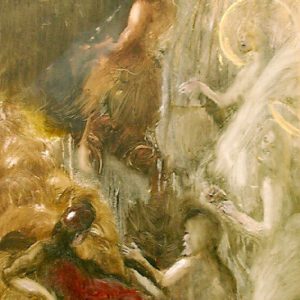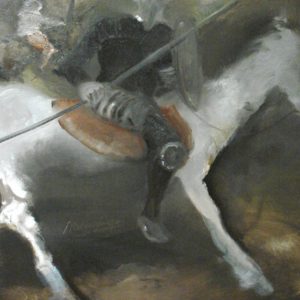Description
Artist/Maker: Yannis Papayannis (b. 1962)
Object/Materials and Techniques: Acrylic on paper
Date: Painted in 2010
Dimensions: H. 40 cm. x W. 50 cm.
Art style: Abstract Art / Pop Surrealism / Lowbrow Art
Current Location: Artist’s collection
Curator’s note: |’n Art| presents three paintings from a series of works Yannis Papayannis felt like creating upon his reading engagement with the book, The Greeks and Greek Love, by James Davidson. The book deals with the complex world of love and homosexuality in Ancient Hellas from where the artist selected some intriguing stories to illustrate giving onto his works a sort of comics effect based on underground aesthetics.
In this artfully executed series, comics, hot rod culture and underground cartoonists seem to have supplied such inspiration to the artist that he attempted to display narratives of mythology and classical antiquity in a distinctly ostentatious and tawdry manner. By means of a near-esoteric devotion to the act of making, along with a spirit of experimentation, he came down to develop his work within an exceptionally polished imagery acted upon comics characters and setting, as how one could describe Lowbrow art, also known as Pop Surrealism.
Towards that end, cartoon-tainted portray and motifs, in their simplicity, suggest a strong thought-provoking allegory as they enliven ancient myths and stories or further spotlight the alluring of a mythological scenery that ends up in transcending this particular series of artworks to become universal and timeless.
The oeuvre Menestratos from the series depicts a story from the Ancient Hellenic mythology with reference to the Drakon Thespiakos (Thespian Dragon), a monstrous serpent which ravaged the land of the Ancient Hellenic city of Thespiae (Thespiai) in Boiotia (Central Hellas). The Dragon was smashed thanks to the sacrifice of the hero Menestratos who leapt between the jowls of the creature carrying a spiked breastplate.
Based on Pausanias writings ‘…In Thespiai (Thespiae) [in Boiotia] is a bronze image of Zeus Soter (Saviour). They say about it that when a Drakon (Dragon-Serpent) was devastating their city, the god commended that every year one of their youths, upon whom the lot fell, should be offered to the monster. Now the names of those who perished they say that they do not remember. But when the lot fell on Kleostratos (Cleostratus), his lover Menestratos (Menestratus), they say, devised a trick. He had made a bronze breastplate with a fish-hook, the point turned outward upon each of its plates. Clad in this breastplate he gave himself up, of his own free will, to the Drakon, convinced that having done so he would, though destroyed himself, proved the destroyer of the monster. This is why the Zeus has been surnamed Saviour.‘
In this light, the Menestratos artwork constitutes a tribute to Eros, the Ancient Hellenic god of sensual love and desire, prostate of the ones in love. The close friendship and bonding of two men, and their victory against the Dragon are metaphorically crowned by the depicted winged Eros, the Ancient Hellenic god of sensual love and desire, prostate of the ones in love.
Yannis Papayannis, being used to foreground the seductively existence of his calm, at times, yet overall disquieting characters, in Menestratos places emphasis on the sentimental impel or force to an action that love, as an instinctive motive, may provoke to the leading figures, culminating to a content ending.
In essence, behind this phenomenally naive, sort of comics display, a powerful statement passes out as an echo of the generally approved expression ‘love can conquer all’. Through a unique mixing process, modern interpretations and ancient references are successfully merged with comics-inspired arrangements or icons of pop culture, poking fun while at the same time addressing diachronic sentimental matters.
Within this framework, past comes up towards future in a ‘sui generis’ fantasy set where Yannis Papayannis’ gratifying surface carry such an expressive power that for anyone who desires to interact with it turns out to be, far and wide, a highly enjoyable experience.
Notation:
- James Davidson is a British classical scholar and history professor at the University of Warwick in England, and a regular contributor to the London Review of Books, among other journals. He specialises in social and cultural history and historiography of ancient Hellas, and has made significant contributions to the study of ancient homosexuality. He was educated at Columbia and Oxford University, where he received a DPhil. From 2001 to 2004 he was a member of the Council for the Society for the Promotion of Hellenic Studies, and from 2000 to 2010 a member of the Classical Association Journals Board. His book The Greeks and Greek Love: a Radical Reappraisal of Homosexuality in Ancient Greece was awarded three international prizes for history among which the Mark Lynton History Prize in 2010. He lives in London.
- Cartooning and plenty other forms of illustration, including comics, graffiti art, animation, along with technology-based tools and techniques, appear to further advance the thriving of a new type of art stream that could be defined as Lowbrow art or Pop Surrealism; a rather successful combination of two powerful stances in art, Pop Art and Surrealism. Finding its cultural traces back in the ‘mainstream’ Los Angeles of the late 1960s, in street art or onto the crude artworks of underground cartoonists, as displayed on the walls of alternative galleries in California and New York, nowadays, the new audacious creative art field with its unconventional character, is assuredly here to stay.
- Pausanias(c. 110 – c. 180) was a Hellenic traveller and geographer of the second century AD. He is famous for his lengthy work entitled Description of Greece (Greek: Ἑλλάδος Περιήγησις, Hellados Periegesis) that describes Ancient Hellas from his personal observations, and provides crucial material and data for making links between classical literature and modern archaeology.
- Thespiae -Thespiaí was an Ancient Hellenic city (Greek: polis) in Boeotia. It stood on level ground mapped by the low range of hills which run eastward from the foot of Mount Helicon to Thebes, near modern Thespies. By the time of the Persian invasion of 480 BCE, Thespiae and Thebes were the only Boeotian cities to send at Thermopylae a contingent of 700 hoplites who remained to fight beside the Spartans on the final day of the battle. In 1997, the Hellenic government dedicated a monument to the Thespians who fell alongside that of the Spartans. After the battle, Thebes was the final Boeotian state to side with the Persians. In doing so they denounced both Plataea and Thespiae to Xerxes I as the only Boeotian states to side with the Hellenes. After the city was burned down by Xerxes, the remaining inhabitants equipped a force of 1,800 men for the allied Hellenic army that fought at Plataea.
Bibliographic References:
- James Davidson, The Greeks and Greek love: a Radical Reappraisal of Homosexuality in Ancient Greece, London: Weidenfeld & Nicolson, 2007, ISBN 9780297819974.
- Pausanias, Description of Greece, 26. 7 (trans. Jones) (Greek travelogue C2nd A.D.)
- Ricardo Martinez, From Pop Surrealism to Lowbrow – Something Got Lost in Translation, London, England, Widewalls.ch., December 5, 2015. Archived from the original on December 11, 2015. Retrieved December 16, 2018.
- Diana Ferguson, Greek Myths and Legends, Collins and Brown, New York, New York, 2000.
- John Pinsent, Greek Mythology, Peter Bedrick Books, New York, New York, 1982.

![Yannis Papayannis - Menestratos (3/3) [From a series after the book The Greeks and Greek Love, by James Davidson]](https://www.n-art.org/wp-content/uploads/2019/04/PAPAGIANNIS-2.10-scaled.jpg)



